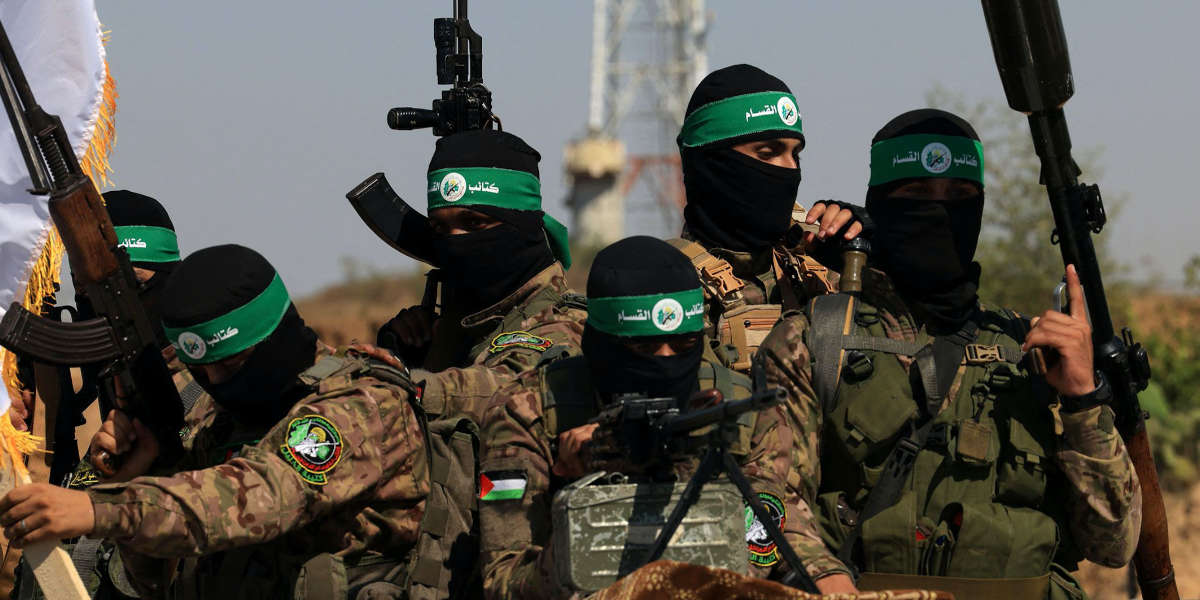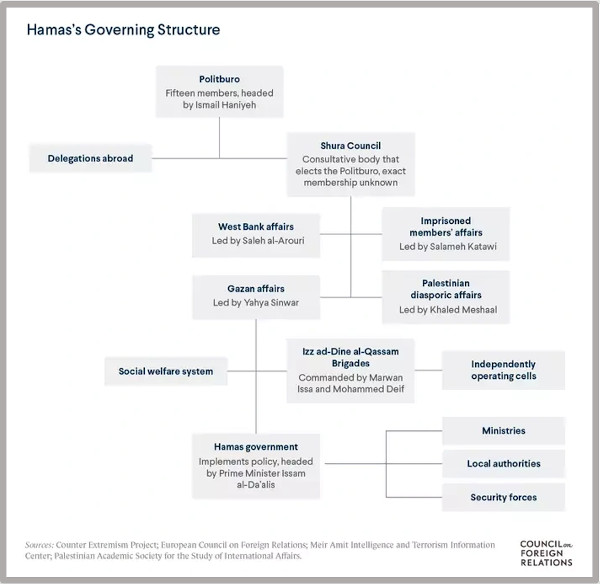In the picture
Image from Hamas propaganda video
On October 7, 2023, Hamas launched a surprise attack on southern Israel, killing more than 1,400 people and taking more than two hundred hostages. Israel has declared war on group in response, penetrating the Gaza Strip with IDF forces in an ongoing ground operation, and has indicated that its army will continue a long campaign until Hamas is completely eliminated. With this escalation in the conflict, Hamas has succeeded in putting the spotlight on its cause and its organization, which begs the question: What is Hamas and where does it come from? What are its goals? How is it organized and with what support?
Hamas is a militant Islamist movement and one of the two main political parties in the Palestinian territories, and is considered a terrorist group by a large part of the international community. The group has politically controlled since 2006 the Gaza Strip, a territory of 365 km² that is home to more than two million Palestinians.
Origins
Hamas makes reference letter the acronym for the Islamic Resistance Movement (Harakat al-Muqawama al-Islamiya) and was founded by Ahmed Yassin, a Palestinian sheikh who after being an activist in the local branches of the Muslim Brotherhood in Egypt established Hamas as the political arm of the Brotherhood in Gaza in December 1987. This follows the outbreak of the first intifada, the Palestinian uprising against the Israeli occupation of the West Bank, Gaza and East Jerusalem. The group presents itself under a nationalist, Islamist and jihadist identity. At the time, Hamas' purpose was to counter the Palestinian Islamic Jihad (PIJ), another organization whose commitment to violently resist Israel threatened to take Palestinian support away from the Brotherhood.
In 1988, Hamas published its charter, advocating the destruction of Israel and advocating the establishment of an Islamic society in historic Palestine. This purpose is part of the strong criticism Yassin expressed of the strategy of civil service examination to Israel of the Palestine Liberation Organization (PLO), led for years by Yasser Arafat. The PLO leader's ideas were linked to socialism and pan-Arabism, ideological currents very popular in the 1960s and 1970s in the Middle East. However, these positions were criticized by Yassin, who perceived them as 'Western' influences. For Yassin, in addition to the struggle against Israel, it was also crucial to preserve 'sharia' and Islamic law as the foundation of an eventual Palestinian state. Moreover, the PLO was highly discredited because it was seen as corrupt and detached from the real problems of the Palestinians, as its leadership was comfortably seated in Tunisia, while the Palestinians were suffering directly from the effects of the intifada.
During the first intifada Hamas played a growing but moderate role, as the most recognizable figure within the Palestinian resistance was Yasser Arafat. However, from the 1990s onwards, its role in Palestinian politics increased considerably thanks to two factors core topic: the training of Hamas' armed wing called the Ezzeldin al-Qassam Brigade and its firm position against any peace agreement .
Hamas thus condemned the Oslo Accords, the historic pact signed by PLO leader Yasser Arafat and Israeli Prime Minister Yitzhak Rabin in 1993. These agreements established limited self-rule for parts of the West Bank and Gaza under a newly created entity called the Palestinian National Authority (PNA). In addition to rejecting the agreements, Hamas condemned the mutual recognition between the PLO and Israel, which Arafat and Rabin officially accepted in letters sent days before Oslo. Consequently, Hamas refused to be part of the newly created PNA and started a campaign of suicide bombings towards Israel that caused it to be labeled as group terrorist by Israel, the United States, the European Union, the United Kingdom or Canada. At the same time, Hamas' name began to resonate more and more in the Middle East region and its influence among the Palestinian population increased. This increase in support for Hamas among Palestinians can be attributed to its steadfast civil service examination towards Israel and the criticism of corruption and ineffectiveness directed towards the PNA and the main party, Fatah.
With the beginning of the second intifada at the end of 2000, the role of Hamas became more prominent, almost at the same level as that of Fatah, despite the fact that the latter occupied governmental positions at that time. On the other hand, despite having suffered major defeats on the ground against Israel and having lost two of its most important leaders - Ahmed Yassin and Abdel Aziz ar-Rantisi - killed in special military operations carried out by the Tsahal, the political influence of Hamas soared during this intifada. On the other hand, Hamas's armed wing was strengthened in these years, as Israel accuses, due to the partnership of states such as Iran or Qatar, as well as armed groups hostile to Israel, such as Hezbollah in southern Lebanon. These external actors have repeatedly expressed their support for Hamas operations, although they have gone so far as to deny providing direct military financial aid .
Hamas' political relevance peaked in 2006 when it won the legislative elections in Gaza, winning over other long-established parties such as Fatah or the Popular Front for the Liberation of Palestine. The perception of Hamas as a threat by Fatah generated growing tensions between the two factions, culminating in an open confrontation for power in 2007. Although Fatah maintained its dominance in the West Bank, Hamas took full control of the Gaza Strip. This division left Palestinian politics and its two territories in a state of fracture and paralysis for years. This status also raised additional concerns for Israel, since, unlike Fatah - which believes in a two-state solution - Hamas believes that Israel must disappear and that only one state can prevail: that of Palestine.
Since then, Israel began to isolate the Gaza Strip, a blockade that has caused a humanitarian crisis among the more than two million inhabitants of the area.
In the period from 2008 to 2021, Israel lived in a state of permanent tension with Hamas. The constant drip of rockets from the terrorist group on Israeli territory raised tensions on at least four occasions, resulting in armed conflicts, in some of which Israel has even temporarily penetrated Gaza with ground forces to "mow the grass", using the IDF's terminology . The first war unleashed by Hamas, in 2008, resulted in the Israeli military offensive 'Cast Lead', which lasted about a month. The second occurred in 2012, culminating in the recognition of Palestine as a 'non-member' observer state by the UN General Assembly. The third armed flare-up, in 2014, was initiated due to attacks from Gaza, culminating in an Israeli ground offensive and a temporary ceasefire in August. Finally, the fourth war, in 2021, began with rocket fire from Gaza and Israeli air strikes, preceded by riots in East Jerusalem.
The maintenance of such intense political and military activity has required Hamas to create a complex but flexible structure, capable of adapting to the permanent Israeli military pressure, and stable sources with which to finance its activity. Both aspects are discussed below.


